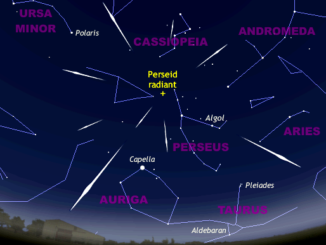
Cometary particles strewn along the orbit of long-period Comet C/1861 G1 (Thatcher) are the genesis of the Lyrid meteors. Those meteoroids entering the Earth’s atmosphere do so at velocities up to 30 miles (48 kilometres) per second, hence it’s not surprising that the streak of light marking their heated demise can be so impressive.
Active from 14–30 April, the International Meteor Organisation predicts the peak of this year’s shower to occur around 18h UT (7pm BST) on Sunday 22 April, which would favour East Africa, the Middle East, India, China, Southeast Asia and Australia. However, the time of the peak is variable from year to year, so the maximum could lie between 10h and 21h UT (11am to 10pm BST).
Even if the predicted peak of the Lyrids occurs in daylight for Western Europe (including the UK), observers looking in the eastern sky after midnight this weekend can expect around a dozen meteors per hour under favourable conditions – particularly if you start your vigil after the waxing Moon sets. (The 5-day-old lunar crescent sets around 1:40am BST on Saturday 21 April for the centre of the UK, and an hour later Sunday morning.)
It follows that the best views are reserved for those dedicated souls prepared to observe in the small hours between moonset and the first light of dawn around 4am BST in the UK when the radiant of the Lyrids is high in the southeast.
As is typical of most meteor showers, fainter Lyrids are the most plentiful, so your chances of observing some are greatly improved if you can find a safe, rural location well away from artificial lights and take 20 minutes or more to ensure that your eyes are fully dark adapted.



